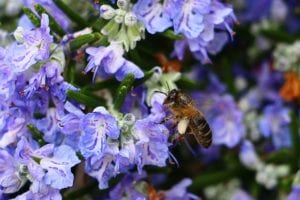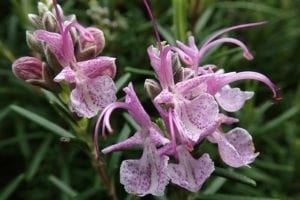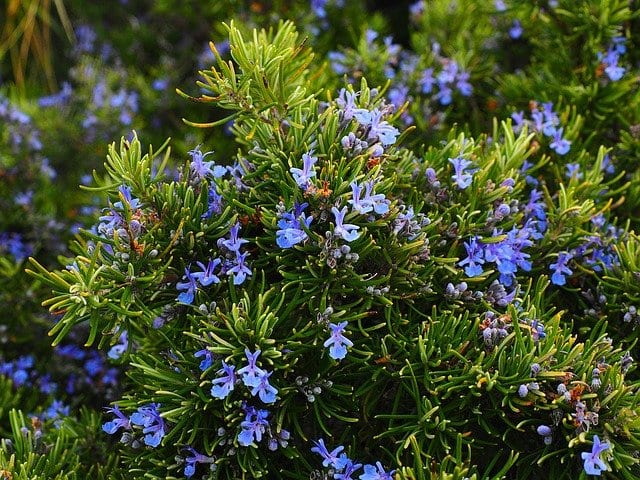Fragrant, evergreen, pollinator-friendly rosemary deserves a spot in your landscape. Take a moment to walk your landscape this winter. Is there wispy backdrop from a deciduous shrub that has lost all its leaves? Did you plant a bush you didn’t realize wasn’t cold hardy and now you have a barren spot where it once stood? Planting rosemary is an easy way to make sure you have some hardy, evergreen plants in your landscape. This hardy herb withstands our winters and thrives in our summers. Rosemary is also an amazing pollinator-attracting plant that doubles as a great tasting herb. It’s easy to see why rosemary is a favorite here at Rainbow Gardens.


Characteristics of Rosemary
Rosemary (Rosmarinus officinalis) is one of the most versatile, evergreen perennials for San Antonio. You can successfully plant it in an herb garden, landscape, or in pots. Deep-green, aromatic foliage makes a striking contrast to the masses of pollinator-attracting flowers that are produced. Numerous tiny flowers may appear in shades of blue, white, purple and even pink. This herb is an outstanding producer of nectar and anyone looking to increase pollinator activity to their landscape should give it serious thought.
Nowadays you can find a great variety of rosemary plants to choose from. All rosemary has the same basic characteristics, but they may differ in the depth of color, width and size of their leaves, or the color of their flowers. Rosemary may also differ slightly in flavor. While the will all have the classic “piney, earthy, rosemary” flavor, different varieties may have a spicier or more pungent flavor, or perhaps a hint of lemon.
Rosemary varieties can also vary in growth habit. You can usually find upright and prostrate rosemary at the nurseries. Upright rosemary grows in a vertical shrub form. Upright rosemary is a beautiful addition to the landscape and can be trained into topiaries shapes. Your imagination is the limit. It can reach heights of about 5-6 feet depending on the variety.
Prostrate rosemary grows in a trailing or cascading form. It will only get to heights of around 2-3 feet tall (depending on variety) and is a wonderful choice for rock walls or borders, or for cascading over the top of pots.
How to Grow Rosemary
Rosemary is a sun lover, growing best when offered a full day of sunshine. If you can’t offer a full day, a minimum of 6-8 hours needs to be provided.
Well-draining soil is a must, and a slightly acidic soil is preferred (6.0 – 7.0 pH level). Adding around 3-4 inches of organic matter, like peat moss or compost, and tilling it into the soil about 6-8 inches down, can help you achieve an ideal environment for rosemary.
Once rosemary is established, it can tolerate a good deal of heat and drought. As a matter of fact, overwatering is what tends to kill this plant. Having said that, please remember that while a plant is developing its root system, water needs are more frequent.
While fertilizing rosemary is not usually necessary, a dose of allpurpose fertilizer given in late February can help revive plants and get them off to a good start in spring.
Using Rosemary in the Kitchen
You can use rosemary fresh or dried. Fresh sprigs of rosemary in a gallon of water with a few slices of orange make an herb-infused drink that refreshes on a hot summer day. Fresh or dried rosemary sprinkled onto oven-roasted potatoes create a savory delight. Sturdy rosemary sprigs can be used in place of skewers for veggies and meat you intend to cook on the grill, infusing your meal with fresh flavor.
The great thing about rosemary is that it is almost always available throughout the year at the nurseries; meaning you can buy rosemary whenever you want to! Winter is still a good time to plant woody perennials like rosemary; they will have time to establish their roots before the heat of summer. Take a walk-about and see if you can find somewhere you can incorporate this incredible, edible, evergreen, perennial herb into your landscape.
The Happy Gardener, Lisa Mulroy


How do I keep rosemary as it keeps dying on me. Does it need a companion?
Hi Linda,
Rosemary does not need a companion. Without knowing how you’ve taken care of it in the past, I will offer the basics for rosemary. Full sun (no less than 6 hours), well-draining soil (no standing water), and allow it to dry out between waterings. What issues have you had with it in the past?
How long can I expect a rosemary plant to last in my landscape? I love them for their fragrance and look, but don’t want to have to replant often. I know they are “perennials ” but what is a reasonable lifespan?
Given the right care and correct growing elements, rosemary has an average lifespan of 10-15 years.